With both sides having lost their opening matches of the tournament, it was crucial for both to get on the board as soon as possible in the SheBelieves Cup. That made for a really intriguing match, to see who would be the one to blink first. This tactical analysis will show how there were very good reasons for the half-time score reading 0-0, and how England needed to change their tactics in the second half, to ensure that they came out on top at full time. The analysis will also show why Japan were unable to score in either half and why they were the ones to concede in the second half.
Lineups
Japan England
S. Ikeda E. Roebuck
R. Shimizu R. Daly
M. Doko S. Houghton
S. Miyake M. Bright
A. Miyagawa D. Stokes
Y. Momiki K. Walsh
H. Sugita C. Kelly
N. Miura J. Nobbs
E. Nakajima G. Stanway
M. Iwabuchi L. Hemp
M. Tanaka B. England
England made six changes from their opening round defeat to the United States, with goalkeeper Carly Telford being replaced by Ellie Roebuck, whilst in defence, Rachel Daly and Demi Stokes swapped with Leah Williamson and Alex Greenwood in the full-back positions. In midfield, Nikita Parris and Jill Scott both moved to the bench, with Jordan Nobbs coming in to make a three-player midfield, whilst strikers Chloe Kelly and Beth England started alongside Lauren Hemp. It was Nikita Parris and Ellen White who made way for them.
Japan also made six changes to the side that lost 3-1 to Spain. Sakiko Ikeda replaced Ayaka Yamashita in goal, whilst Saki Kumagai, Moeka Minami, Jun Endo, Mayu Ikejiri, and Yuika Sugasawa all dropped to the bench. In came Mayo Doko, Shiori Miyake, Asato Miyagawa, Yuka Momiki and Mina Tanaka to take their places.
England’s defensive structure
England’s defensive structure was organised and set up really well, with three clear ranks in place. They were also positioned narrowly, with their tactics clearly being to force Japan to play outside them, and try and open them up that way, which is much more difficult to do.

You can also see in this image how, in the attack, Beth England was further forward, meaning that England’s set up had a prong at the end of it. This meant that England were able to cover more ground, taking more away from Japan. It also was another way of England forcing Japan to play the ball into wider areas, and move it up the pitch through those channels because that served the same purpose as England setting up narrowly. The whole plan was to stop Japan using the middle of the pitch to advance up.
England’s main problem has been defending in recent matches, and these tactics were perhaps a way of addressing this. It has been interesting to see head coach Phil Neville playing around with his defence, obviously looking at who works best with who. Again, this is clearly him attempting to fix England’s biggest problem at the moment.
The result of England’s defensive structure meant that Japan could only play long or wide balls. This sounds obvious, but the simple benefit to England is that it is much more easy to intercept balls in the air, and to block crosses from coming into their box, than it is when teams dribble the ball through the central channel. This was obvious in how Japan played during the first half, because they were constantly getting players into the final third, yet had no way of reaching them because of England’s defensive tactics. There was also a lack of quality from Japan, but that was more because of how England made them play than anything else.
England’s attack
We have looked at how good England’s defence was organised, so now let’s flip it on its head and analyse their attack. This started well, with three players at the front meaning that there were plenty of options when they did get the ball.

Here, you can see how Beth England has come short to receive the pass, whilst the two other forwards who started this game, Everton Women’s Chloe Kelly and Manchester City Women’s Lauren Hemp, have made the run behind her, unlocking the opportunities for Beth England to move the ball to.
This was how the attack started well, but as the game went on, overall England’s attack was disappointing.
If we look at their shape when the ball is with Japan’s defence, we can see how England have clearly gone out with the intention of playing counter-attacking football. They have set up in just such a way.
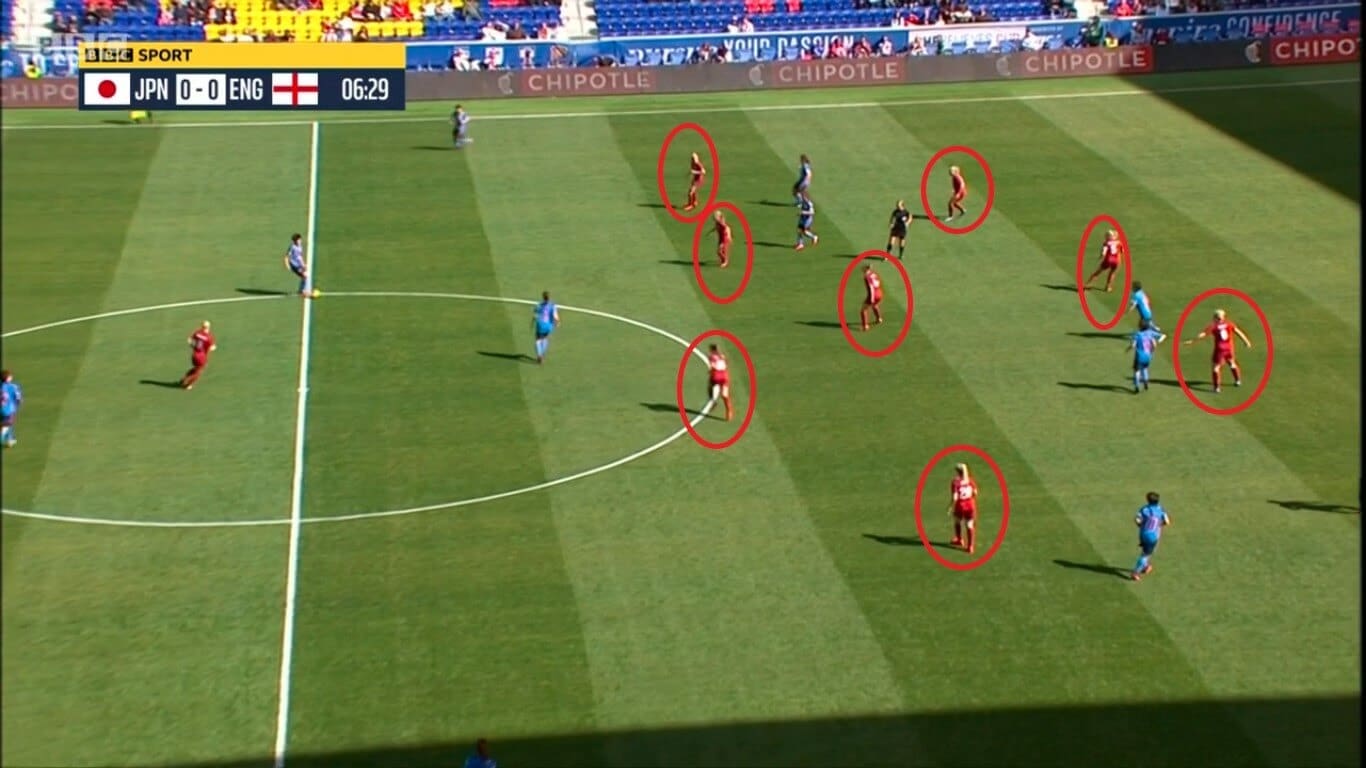
You can see how, in this formation, they aren’t going to be attacking too much, and will just sit back and defend. They have 10 players behind the ball in the above image, which really says it all about their first half. Beth England has no support, if she does manage to get hold of the ball. Contrast this to the earlier image, where Kelly and Hemp were running off her into the forward areas, and you can see how much this influenced the goalless half-time score.
Another example is here.
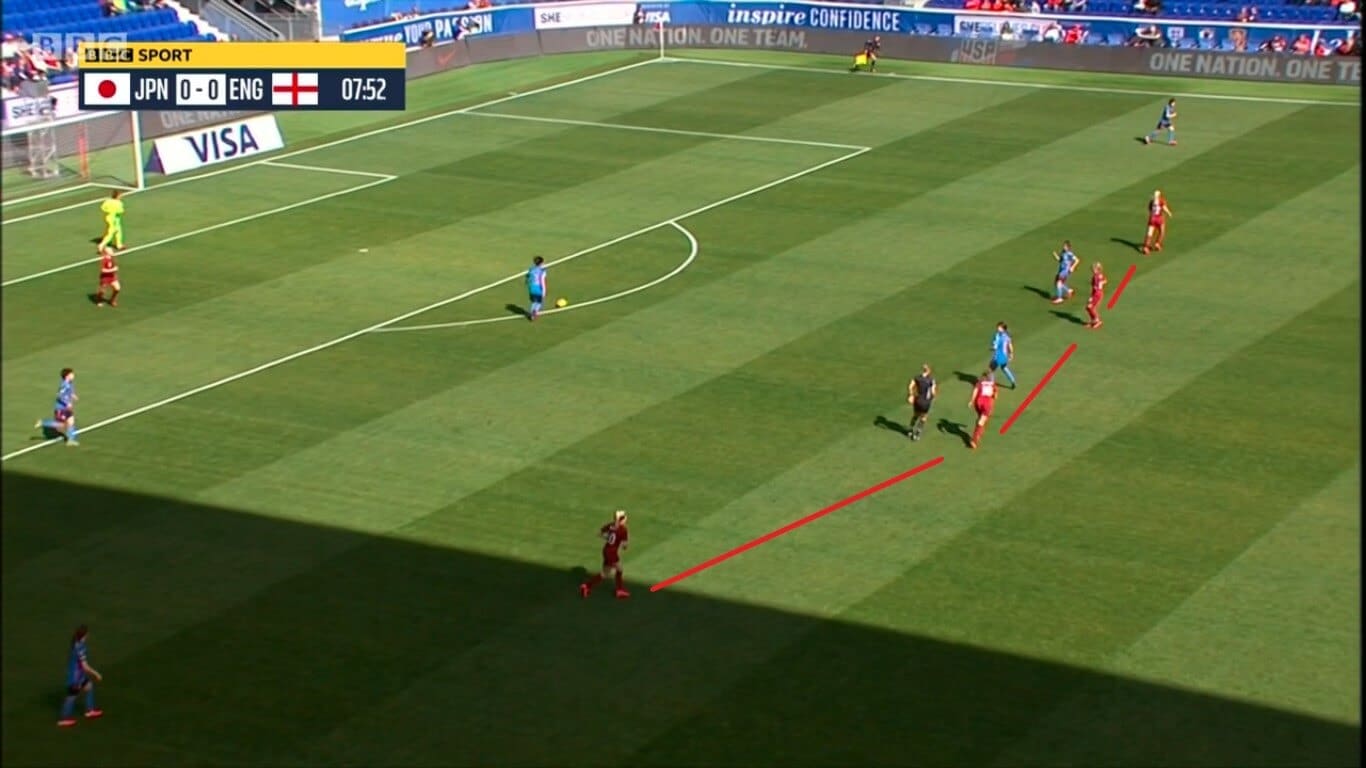
Again, Beth England has been isolated whilst Kelly and Hemp have now dropped back to become wingers, rather than strikers. They have created a line of four, operating behind the lone striker, which, whilst Japan are now forced to play wider from their defence, rather than the midfield, also meant that England had no options going forwards, as mentioned before.
This all made it very easy to defend against, as far as Japan were concerned.
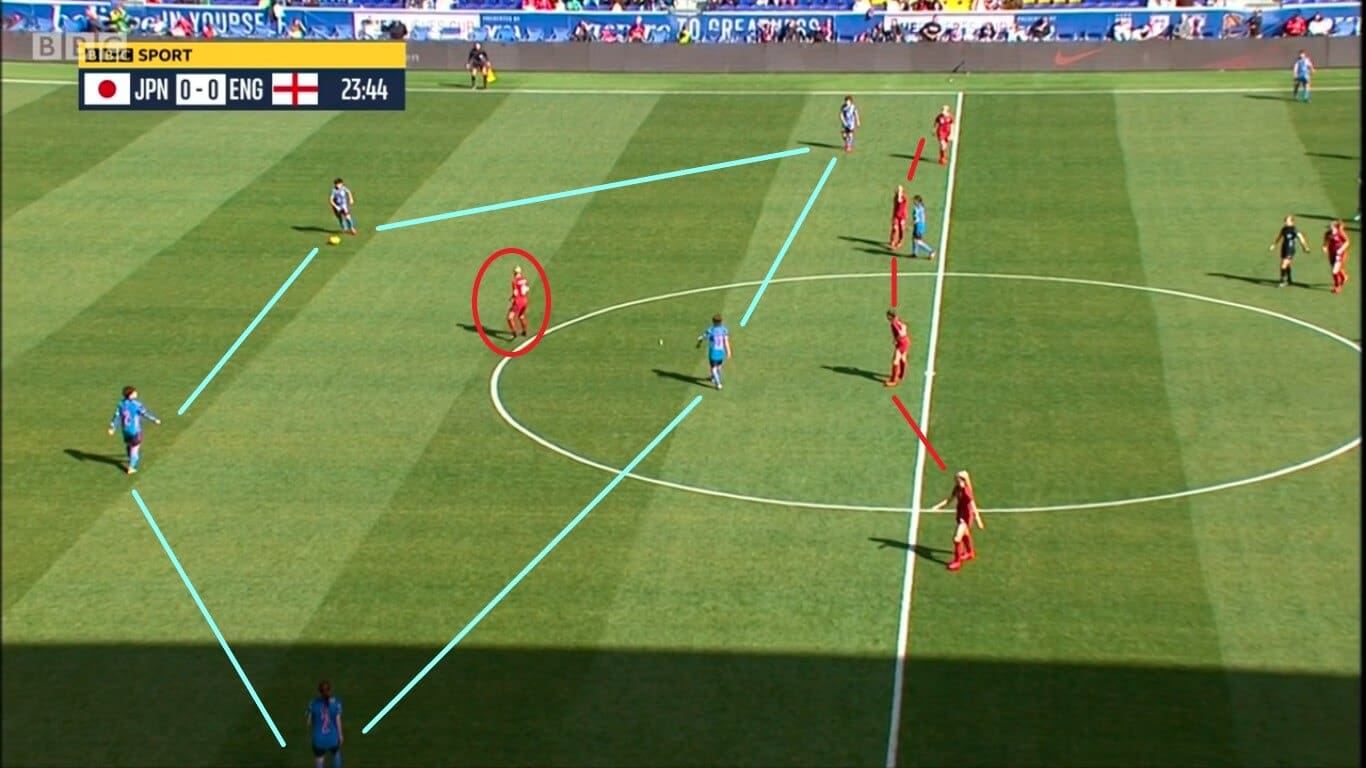
Beth England is again isolated in attack, and this time has been surrounded by the Japanese defence. The new line of four is not really providing any threat to Japan’s defensive line and is instead just a barrier to stop Japan attacking. This, combined with Japan’s lack of quality in the final third, explains why neither side scored in the first half; neither side wanted to risk anything in attack.
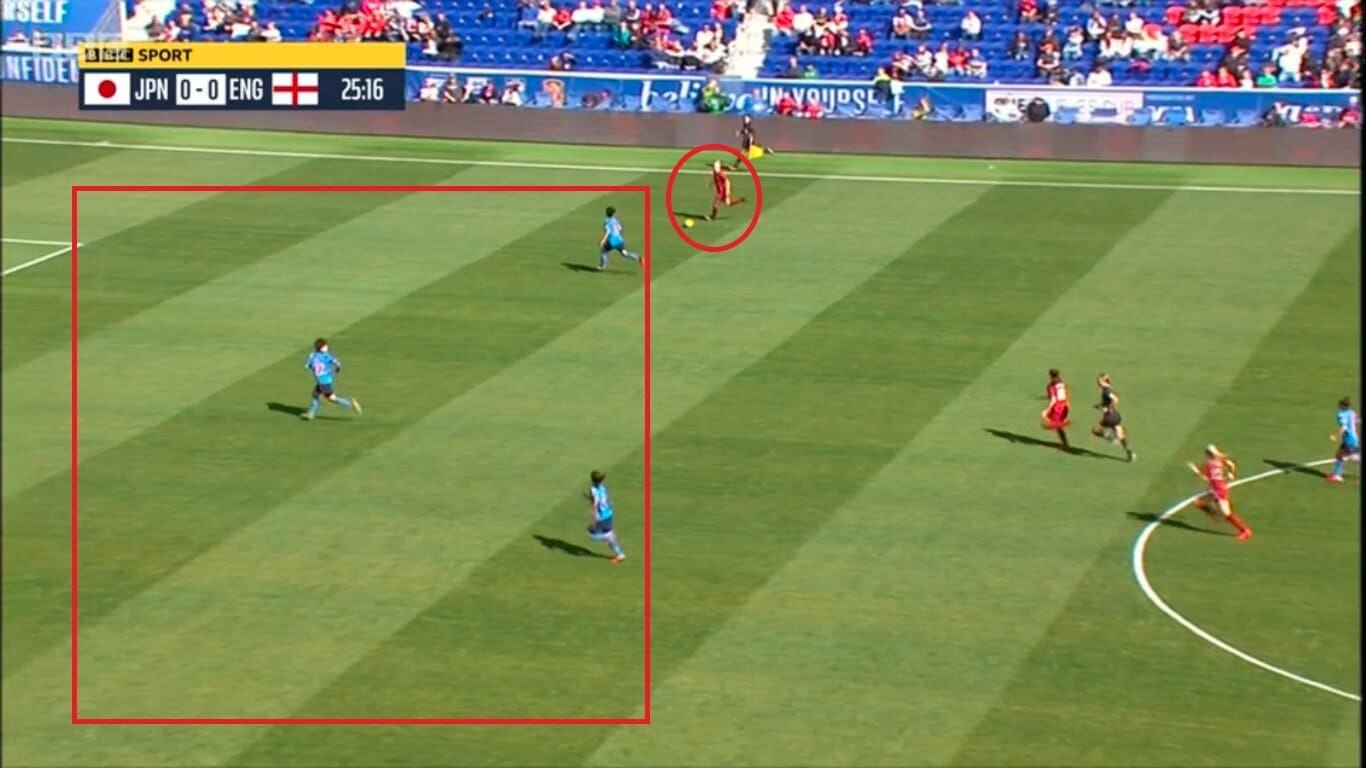
This image shows what came of England’s negativity in attack, because they have no options in front of the ball, and yet this would have been a perfect chance to shoot at goal. Too many times in the first half, all that was needed was for one player to make a run forwards, and England would maybe have been able to score.
It seems unfair to keep mentioning her, but Beth England, as the striker on the pitch expected to be England’s main threat, endured a really tough first 45 minutes.
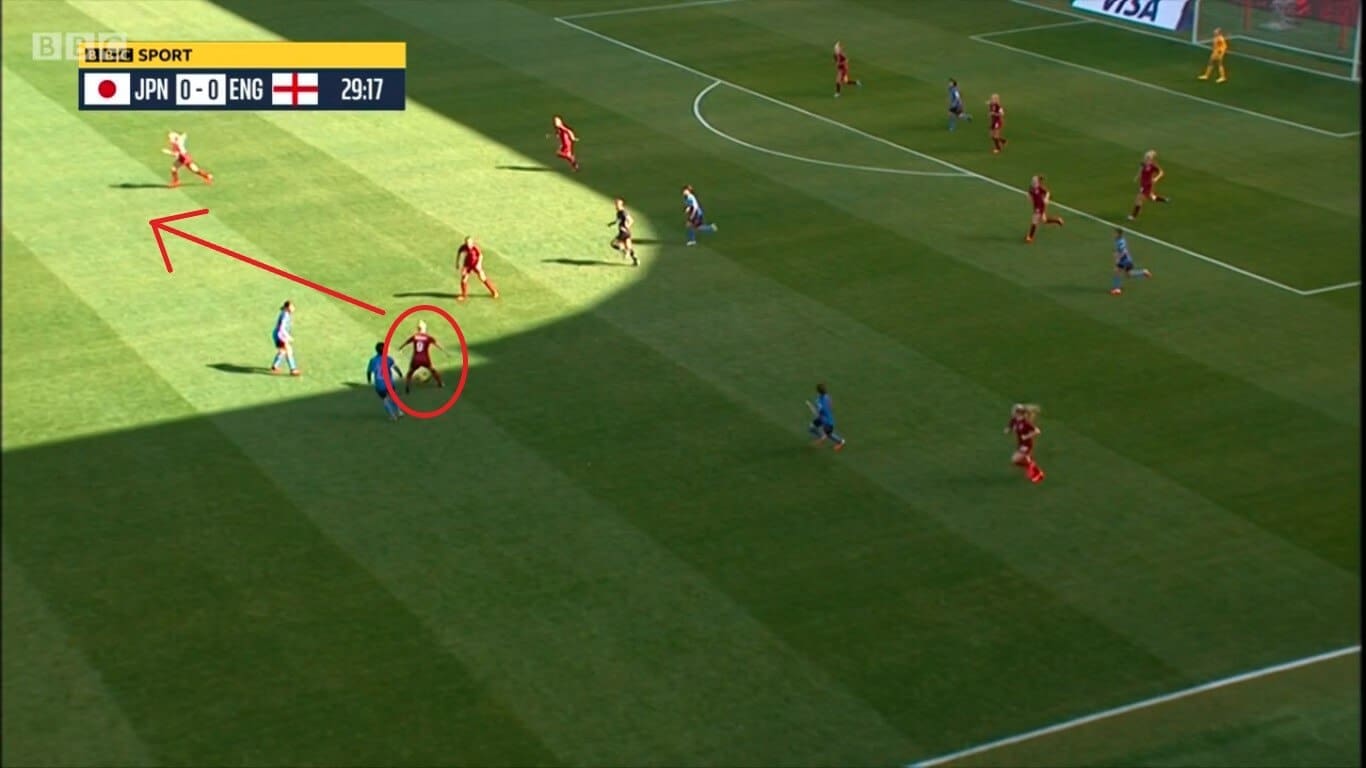
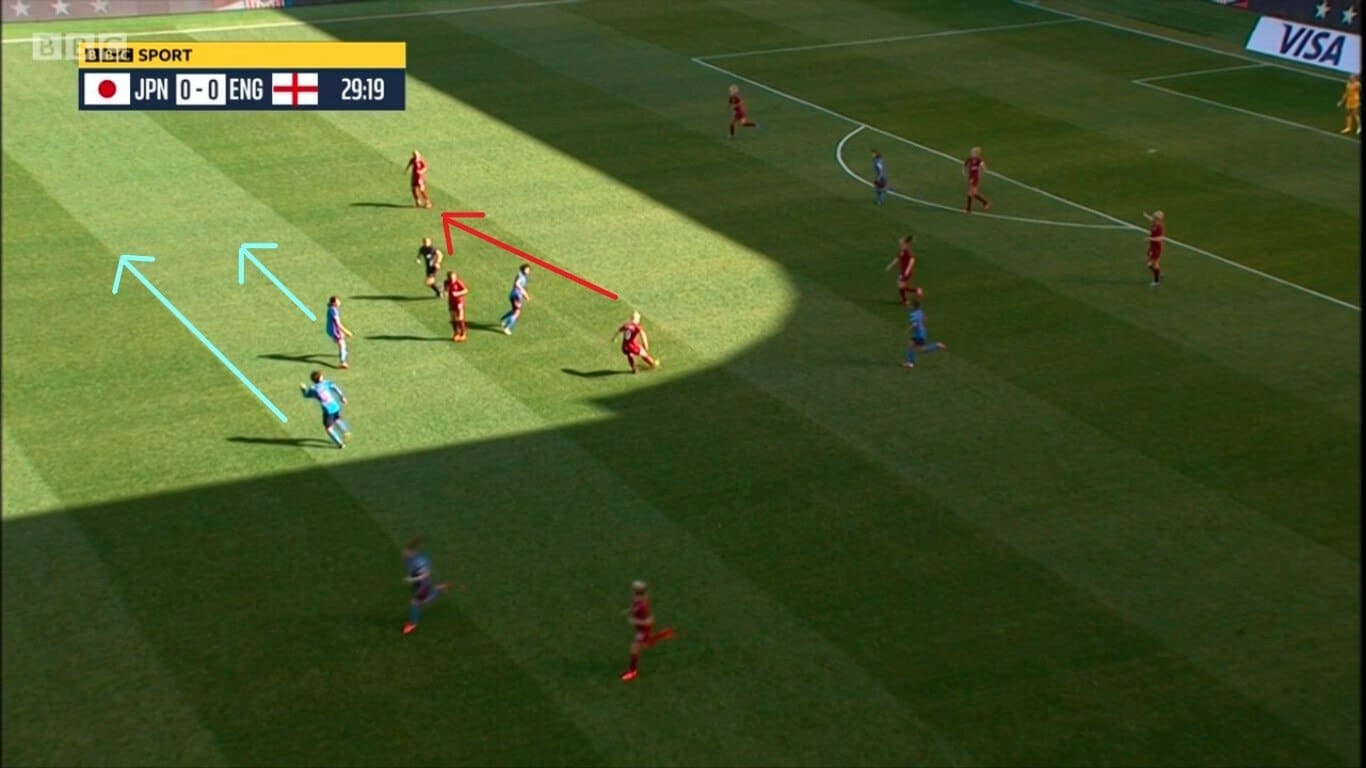
In this instance, she has won the ball after a Japan corner, but in the first of these two images, you can see how she could have played a quick ball out to her teammate, and got a counter-attack underway. However, the second image shows what she actually did, and instead of playing the quick ball, she has dribbled back towards her goal before making a similar pass. This time though, Japan are in position to stop the counter-attack from happening.
The point being made by all of these examples is that England as a team were just being too negative in the first half. England’s defence was the reason why Japan didn’t score in the first half, and England’s attack was the reason England didn’t score in the first half either.
Clearly, given all of this, something had to change for England in the second half, if they were to have any chance of scoring, and any chance of winning this hugely important match. That is exactly what happened.
The main issue was that Arsenal Women midfielder Jordan Nobbs was not being used in the correct way in the first half. With England setting up in a 4-3-3 formation, Nobbs was used on the right side of the central three, but with England sitting back, she was restricted from doing what she does best. When playing for Arsenal, she tends to play in the no. 10 position, behind the striker. She is given the freedom to move around, creating opportunities for others with clever passes and good movements. That’s what she does best.
In this game, it was different. She was very quiet in the midfield until she did start to move forwards. It was telling that when she got going, England got going too.
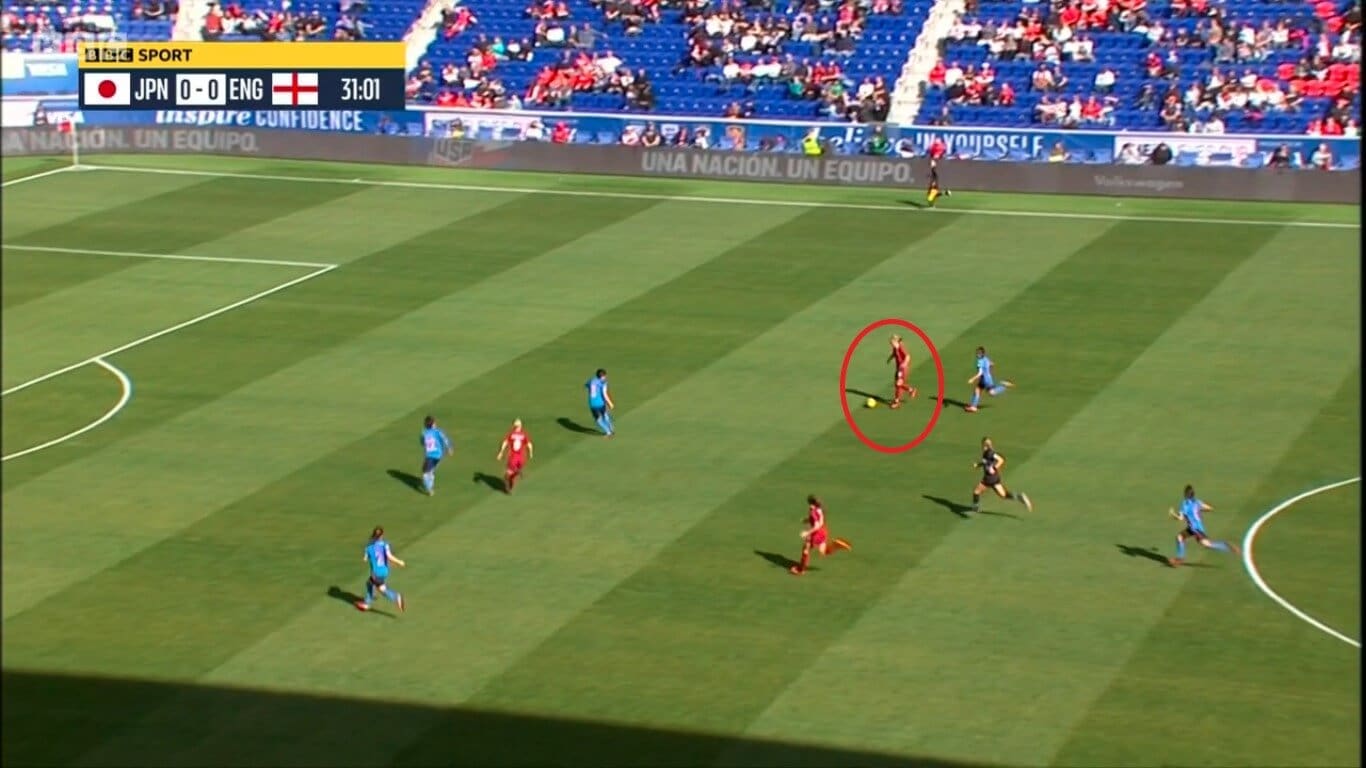
This was England’s best spell in the first half, and Nobbs was central to it. She carried the ball forward before playing it through into the area, creating the opportunity.
This led to more of England’s players getting forward, encouraged by the fact that they now carried a threat to Japan’s backline. Nobbs in particular seemed have been released to do what she does best.
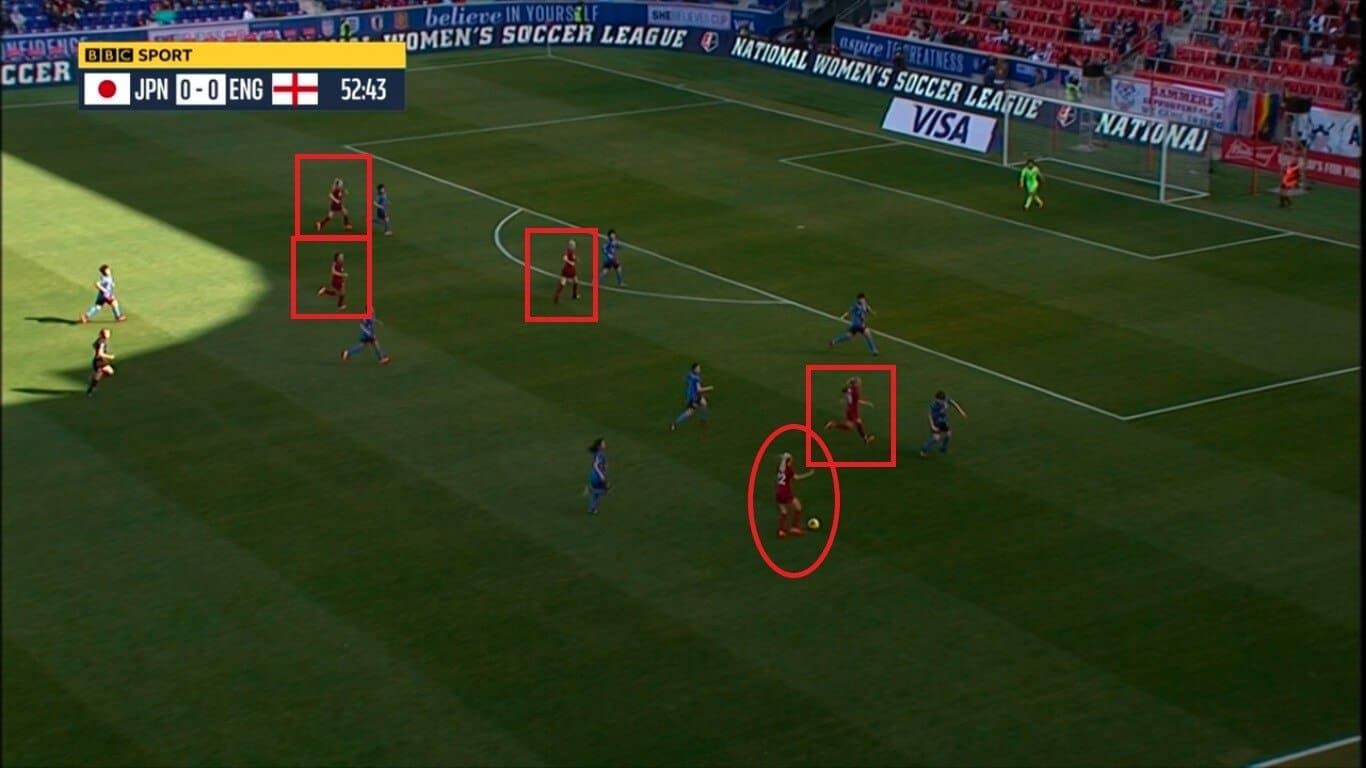
England were now being more positive and threatening in their attack. In the first half, if you remember, when Beth England had the ball, there were no players available in the middle of the pitch. Now look at the above image, and you can see how England now had several options in the middle of the pitch, and are being so much more creative and adventurous with them.
The second half also saw England switch their tactics to utilise two players upfront. Jordan Nobbs was now playing as part of that front two, and this made a huge difference to the way they played. Beth England was not isolated anymore, and you can see below how much more comfortable it seemed for her after this tactical switch.
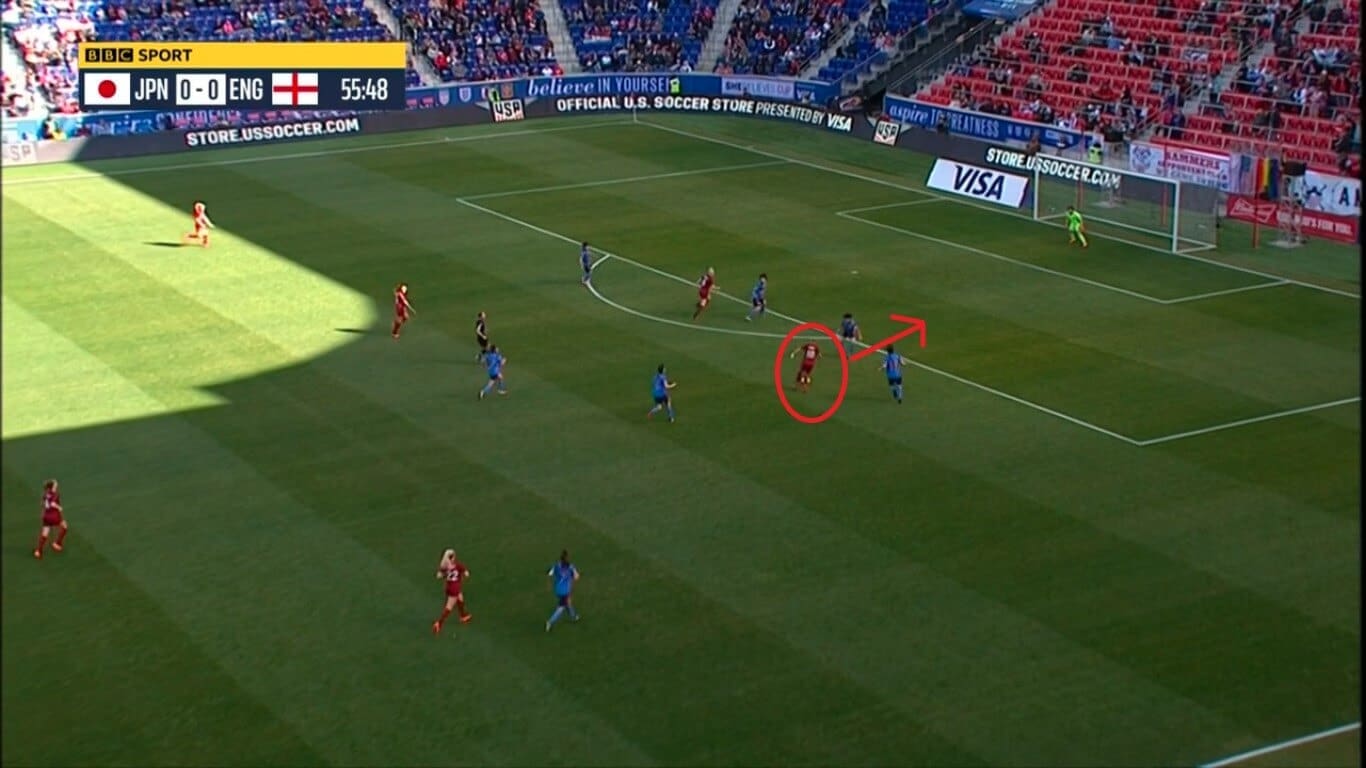
For Chelsea Women, where she has scored 21 goals this season, she is used to playing in a front two with new signing Sam Kerr, who is very creative in attack. Therefore, giving her Jordan Nobbs as a strike partner seemed to restore her confidence. She was making more runs and played in her usual free way once England had switched their tactics to play in this way.
Once England had made their substitutions, bringing on Ellen White, Toni Duggan and Nikita Parris, England never looked back. Duggan and Parris played as wingers, with Nobbs and White combining to provide the attacking threat that the team had been crying out for.
This might seem like a really long-winded explanation, but ultimately the underlying point is this; in the first half, England were negative in attack, and carried no threat whatsoever. In the second half, England changed their tactics, pushing Jordan Nobbs further up the field and using her creativity to good effect, and it made the difference in the game.
Hina Sugita
The final point to make is about one of Japan’s players; Hina Sugita. She occupies the role of the defensive midfielder who is the midfield anchor for her team. She was hugely important to Japan’s play, and you can see this in the image below.
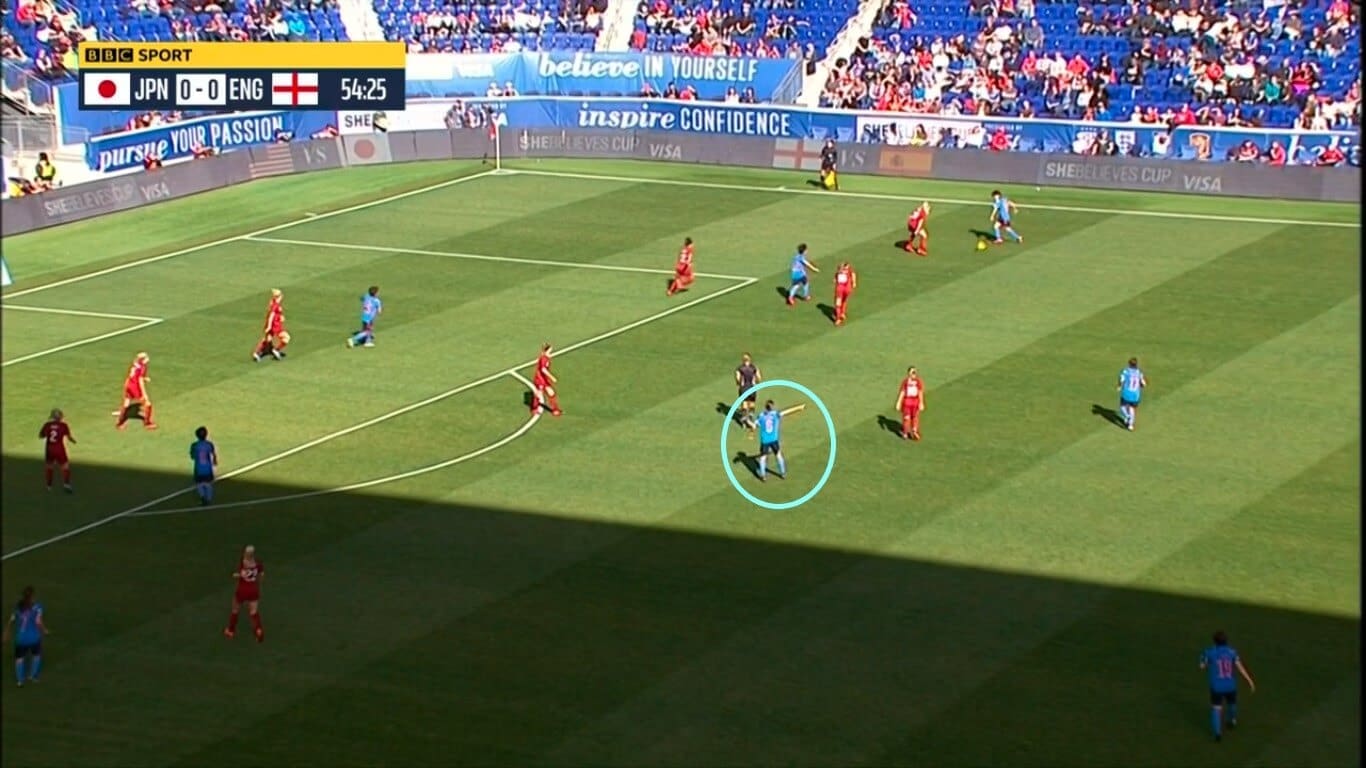
You can see how she has stayed back from the forwards and instead is waiting until she is needed. She directed the play with her passing, and her eye for where the ball should go next to open up the England defensive effort. You can see above how she is pointing, because in these situations, she is the one helping her team to really attack with purpose.
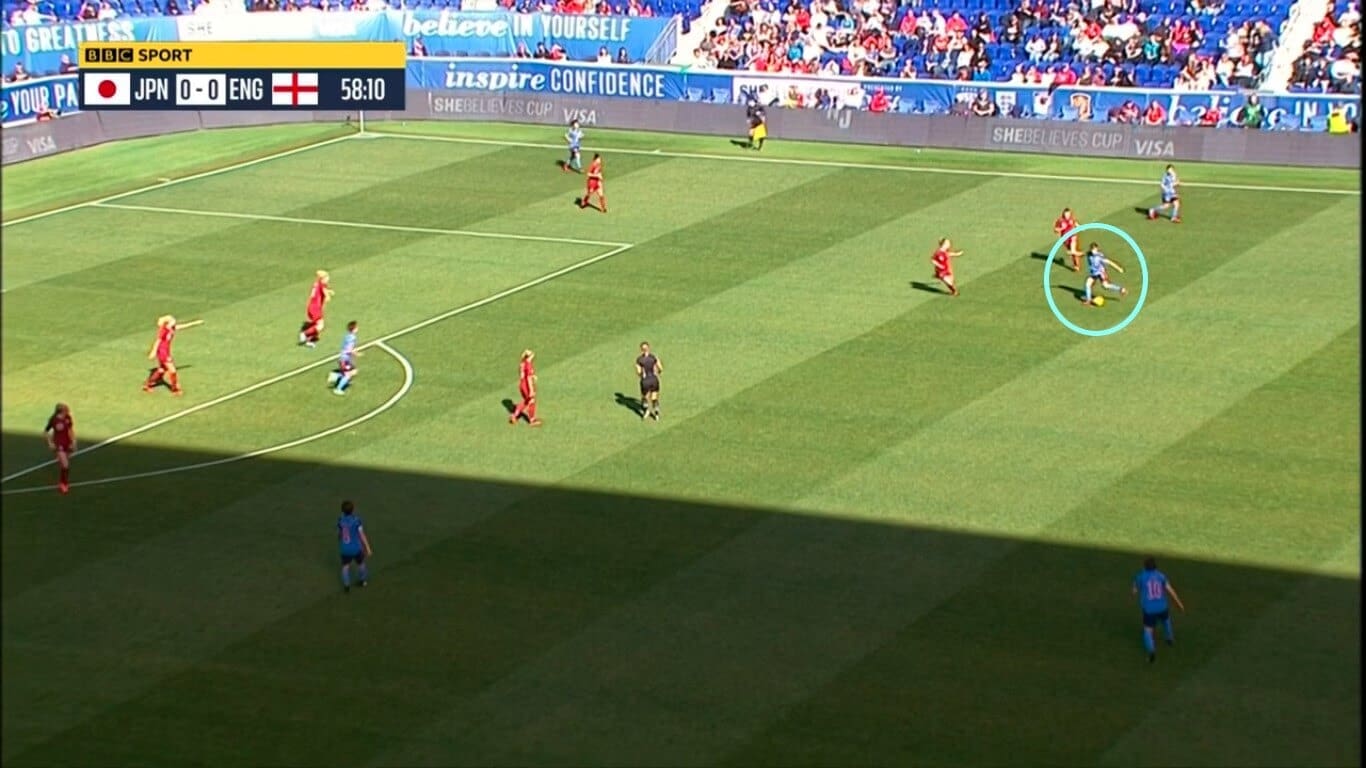
Here, you can see Sugita’s role more clearly. She has just received the ball, and is preparing to pass it to other areas, in an effort to open up some space in the England defence. Having this sort of player in your team means there is more chance of you playing quicker balls, and catching out your opponents by creating the space to attack into, just as Sugita is doing.
This analysis mentioned how Japan were forced into playing long balls over the top of England’s well-organised defence in the first half, and it was Sugita who was often the one looking to play those passes. In the second half, she was again performing this role, as shown.
Whilst Japan didn’t score, they did have a few good opportunities too, and they wouldn’t have come about if it hadn’t been for Sugita occupying these roles.
Conclusion
To conclude, this was a nervy match for both sides, and it showed in the lack of quality on show. Both sides were reluctant to go for it and sat back, and that’s why it was 0-0 at half-time. The second half saw England attack much more positively and freely, and Japan, as a result, were unable to sustain their own threats, and England’s strong defence and newfound attacking threat was what saw them through in the end. Bringing on substitutes Toni Duggan and Nikita Parris had the desired effect because it allowed Jordan Nobbs to play more centrally, behind the striker, and that was what won England the match.




Comments